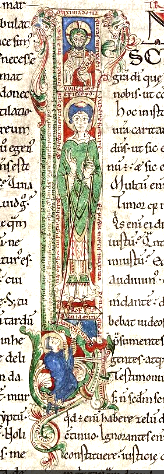As I said in my introductory post, my direction of research on this project is Durham’s rich collection of manuscripts of canon law. What exactly does that entail? I have chosen to narrow my focus initially to 1070-1170, and to start with one man and three manuscripts.
The man: William of St-Calais

William of St-Calais was Bishop of Durham 1080-1096. Among the fifty books he is recorded as having donated (discussed here), there is Decreta pontificum. This manuscript has been identified as the copy of the Collectio Lanfranci now in Cambridge, Peterhouse MS 74.
William was one of the many Norman appointments made by William the Conqueror as a means to solidify his rule. This was especially important for William in the North, which had already rebelled and which also bordered Scotland, ruled by the aggressive King Malcolm III at the time.
What matter most about him for my immediate research are his place in reform and his use of canon law. William of St-Calais fits the profile of an eleventh-century reforming bishop quite well. He kicks out the married clergy from Durham Cathedral. He refounds the religious house there following the Rule of St Benedict. He begins the rebuilding of his cathedral.
Two Manuscripts
According to Symeon of Durham’s deliberately opaque De Iniusta vexacione, in 1188, William finds that he is having many of his temporal possessions confiscated by King William Rufus, the son of William the Conqueror, and himself and his knights being harassed. He is called to court at Old Sarum on suspicion of supporting William Rufus’ brother, Robert, in a conspiracy. Throughout the entire proceedings, he claims that he will only answer according to the canons and that the laymen present are not legally competent to judge him. Lanfranc, Archbishop of Canterbury, argues the opposite, since William’s trial had to do with his loyalty to William Rufus and his temporal possessions, not his spiritual authority as bishop of Durham.
Throughout, he seems to be making reference to a book.
We have that book: Cambridge, Peterhouse MS 74.
We also have what is probably the exemplar (certainly the ancestor) of that book, Lanfranc’s own copy of the canon law collection that modern scholars give his name, Collectio Lanfranci, also in Cambridge, Trinity College B. 16. 44.
Mark Philpott has already shown us that William marked his copy in canons that he refers to in Die iniusta vexacione. I suspect more revelations await us when I get to Cambridge.
A Third Manuscript: Durham Cathedral Library B.IV.18
I have not made it to Cambridge, so besides reading about Durham and canon law in this period, I have spent time with a manuscript that is still here, and will soon be digitised, B.IV.18. This is a manuscript from after 1123, written in Canterbury. It begins with an extreme abridgement of Collectio Lanfranci, then some letters of Gregory the Great, followed by various items related to current issues in canon law, such as the Investiture Controversy.
It also includes the Cena Cypriani, an extended fifth-century biblical parody/in-joke and tour-de-force of allegorical punning, inserted seemingly at random in the midst of the canon law, and a series of extracts on the Trinity. Finally, a later hand added some Hugh of St Victor for good measure.
This manuscript points to the place of canon law within intellectual history. Cambridge, Peterhouse 74, was a canon law book that was clearly used by its owner to plead his case in court. Durham Cathedral, B.IV.18, would be almost useless to argue a case. Nonetheless, it must have had a purpose for the Canterbury monk who compiled it and the Durham monks into whose library it found its way.
My argument is that said purpose was the acquisition and assimilation of knowledge. We need to stop thinking about canon law books as merely utilitarian, and I hope that as my work on this manuscript and its context progresses, I will be able to demonstrate canon law’s wider uses and importance in the Middle Ages.
Image provided by Durham Priory Library Project – a collaboration between Durham University and Durham Cathedral, under Creative Commons Licence.
